 |
ORBITAL MECHANICS |
 |
ORBITAL MECHANICS |
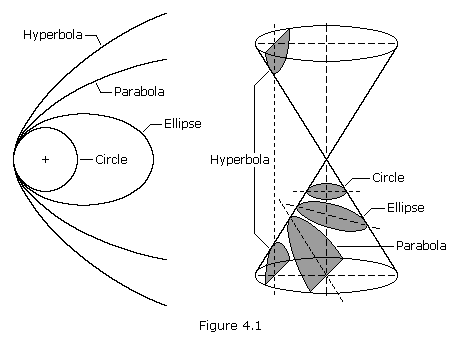 A conic section, or just conic, is a curve formed by passing a plane through a right circular cone. As shown in Figure 4.1, the angular orientation of the plane relative to the cone determines whether the conic section is a circle, ellipse, parabola, or hyperbola. The circle and the ellipse arise when the intersection of cone and plane is a bounded curve. The circle is a special case of the ellipse in which the plane is perpendicular to the axis of the cone. If the plane is parallel to a generator line of the cone, the conic is called a parabola. Finally, if the intersection is an unbounded curve and the plane is not parallel to a generator line of the cone, the figure is a hyperbola. In the latter case the plane will intersect both halves of the cone, producing two separate curves.
A conic section, or just conic, is a curve formed by passing a plane through a right circular cone. As shown in Figure 4.1, the angular orientation of the plane relative to the cone determines whether the conic section is a circle, ellipse, parabola, or hyperbola. The circle and the ellipse arise when the intersection of cone and plane is a bounded curve. The circle is a special case of the ellipse in which the plane is perpendicular to the axis of the cone. If the plane is parallel to a generator line of the cone, the conic is called a parabola. Finally, if the intersection is an unbounded curve and the plane is not parallel to a generator line of the cone, the figure is a hyperbola. In the latter case the plane will intersect both halves of the cone, producing two separate curves.
We can define all conic sections in terms of the eccentricity. The type of conic section is also related to the semi-major axis and the energy. The table below shows the relationships between eccentricity, semi-major axis, and energy and the type of conic section.
| Conic Section | Eccentricity, e | Semi-major axis | Energy |
|---|---|---|---|
| Circle | 0 | = radius | < 0 |
| Ellipse | 0 < e < 1 | > 0 | < 0 |
| Parabola | 1 | infinity | 0 |
| Hyperbola | > 1 | < 0 | > 0 |
Satellite orbits can be any of the four conic sections. This page deals mostly with elliptical orbits, though we conclude with an examination of the hyperbolic orbit.
To mathematically describe an orbit one must define six quantities, called orbital elements. They are
![]()
![]()
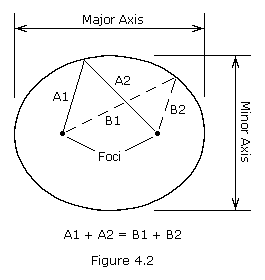 An orbiting satellite follows an oval shaped path known as an ellipse with the body being orbited, called the primary, located at one of two points called foci. An ellipse is defined to be a curve with the following property: for each point on an ellipse, the sum of its distances from two fixed points, called foci, is constant (see Figure 4.2). The longest and shortest lines that can be drawn through the center of an ellipse are called the major axis and minor axis, respectively. The semi-major axis is one-half of the major axis and represents a satellite's mean distance from its primary. Eccentricity is the distance between the foci divided by the length of the major axis and is a number between zero and one. An eccentricity of zero indicates a circle.
An orbiting satellite follows an oval shaped path known as an ellipse with the body being orbited, called the primary, located at one of two points called foci. An ellipse is defined to be a curve with the following property: for each point on an ellipse, the sum of its distances from two fixed points, called foci, is constant (see Figure 4.2). The longest and shortest lines that can be drawn through the center of an ellipse are called the major axis and minor axis, respectively. The semi-major axis is one-half of the major axis and represents a satellite's mean distance from its primary. Eccentricity is the distance between the foci divided by the length of the major axis and is a number between zero and one. An eccentricity of zero indicates a circle.
Inclination is the angular distance between a satellite's orbital plane and the equator of its primary (or the ecliptic plane in the case of heliocentric, or sun centered, orbits). An inclination of zero degrees indicates an orbit about the primary's equator in the same direction as the primary's rotation, a direction called prograde (or direct). An inclination of 90 degrees indicates a polar orbit. An inclination of 180 degrees indicates a retrograde equatorial orbit. A retrograde orbit is one in which a satellite moves in a direction opposite to the rotation of its primary.
Periapsis is the point in an orbit closest to the primary. The opposite of periapsis, the farthest point in an orbit, is called apoapsis. Periapsis and apoapsis are usually modified to apply to the body being orbited, such as perihelion and aphelion for the Sun, perigee and apogee for Earth, perijove and apojove for Jupiter, perilune and apolune for the Moon, etc. The argument of periapsis is the angular distance between the ascending node and the point of periapsis (see Figure 4.3). The time of periapsis passage is the time in which a satellite moves through its point of periapsis.
Nodes are the points where an orbit crosses a plane, such as a satellite crossing the Earth's equatorial plane. If the satellite crosses the plane going from south to north, the node is the ascending node; if moving from north to south, it is the descending node. The longitude of the ascending node is the node's celestial longitude. Celestial longitude is analogous to longitude on Earth and is measured in degrees counter-clockwise from zero with zero longitude being in the direction of the vernal equinox.
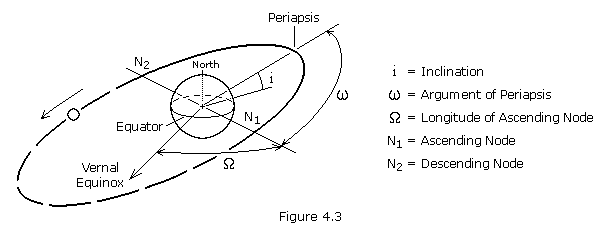
In general, three observations of an object in orbit are required to calculate the six orbital elements. Two other quantities often used to describe orbits are period and true anomaly. Period, P, is the length of time required for a satellite to complete one orbit. True anomaly, ![]() , is the angular distance of a point in an orbit past the point of periapsis, measured in degrees.
, is the angular distance of a point in an orbit past the point of periapsis, measured in degrees.
For a spacecraft to achieve Earth orbit, it must be launched to an elevation above the Earth's atmosphere and accelerated to orbital velocity. The most energy efficient orbit, that is one that requires the least amount of propellant, is a direct low inclination orbit. To achieve such an orbit, a spacecraft is launched in an eastward direction from a site near the Earth's equator. The advantage being that the rotational speed of the Earth contributes to the spacecraft's final orbital speed. At the United States' launch site in Cape Canaveral (28.5 degrees north latitude) a due east launch results in a "free ride" of 1,471 km/h (914 mph). Launching a spacecraft in a direction other than east, or from a site far from the equator, results in an orbit of higher inclination. High inclination orbits are less able to take advantage of the initial speed provided by the Earth's rotation, thus the launch vehicle must provide a greater part, or all, of the energy required to attain orbital velocity. Although high inclination orbits are less energy efficient, they do have advantages over equatorial orbits for certain applications. Below we describe several types of orbits and the advantages of each:
Geosynchronous orbits (GEO) are circular orbits around the Earth having a period of 24 hours. A geosynchronous orbit with an inclination of zero degrees is called a geostationary orbit. A spacecraft in a geostationary orbit appears to hang motionless above one position on the Earth's equator. For this reason, they are ideal for some types of communication and meteorological satellites. A spacecraft in an inclined geosynchronous orbit will appear to follow a regular figure-8 pattern in the sky once every orbit. To attain geosynchronous orbit, a spacecraft is first launched into an elliptical orbit with an apogee of 35,786 km (22,236 miles) called a geosynchronous transfer orbit (GTO). The orbit is then circularized by firing the spacecraft's engine at apogee.
Polar orbits (PO) are orbits with an inclination of 90 degrees. Polar orbits are useful for satellites that carry out mapping and/or surveillance operations because as the planet rotates the spacecraft has access to virtually every point on the planet's surface.
Walking orbits: An orbiting satellite is subjected to a great many gravitational influences. First, planets are not perfectly spherical and they have slightly uneven mass distribution. These fluctuations have an effect on a spacecraft's trajectory. Also, the sun, moon, and planets contribute a gravitational influence on an orbiting satellite. With proper planning it is possible to design an orbit which takes advantage of these influences to induce a precession in the satellite's orbital plane. The resulting orbit is called a walking orbit, or precessing orbit.
Sun synchronous orbits (SSO) are walking orbits whose orbital plane precesses with the same period as the planet's solar orbit period. In such an orbit, a satellite crosses periapsis at about the same local time every orbit. This is useful if a satellite is carrying instruments which depend on a certain angle of solar illumination on the planet's surface. In order to maintain an exact synchronous timing, it may be necessary to conduct occasional propulsive maneuvers to adjust the orbit.
Molniya orbits are highly eccentric Earth orbits with periods of approximately 12 hours (2 revolutions per day). The orbital inclination is chosen so the rate of change of perigee is zero, thus both apogee and perigee can be maintained over fixed latitudes. This condition occurs at inclinations of 63.4 degrees and 116.6 degrees. For these orbits the argument of perigee is typically placed in the southern hemisphere, so the satellite remains above the northern hemisphere near apogee for approximately 11 hours per orbit. This orientation can provide good ground coverage at high northern latitudes.
Hohmann transfer orbits are interplanetary trajectories whose advantage is that they consume the least possible amount of propellant. A Hohmann transfer orbit to an outer planet, such as Mars, is achieved by launching a spacecraft and accelerating it in the direction of Earth's revolution around the sun until it breaks free of the Earth's gravity and reaches a velocity which places it in a sun orbit with an aphelion equal to the orbit of the outer planet. Upon reaching its destination, the spacecraft must decelerate so that the planet's gravity can capture it into a planetary orbit.
To send a spacecraft to an inner planet, such as Venus, the spacecraft is launched and accelerated in the direction opposite of Earth's revolution around the sun (i.e. decelerated) until it achieves a sun orbit with a perihelion equal to the orbit of the inner planet. It should be noted that the spacecraft continues to move in the same direction as Earth, only more slowly.
To reach a planet requires that the spacecraft be inserted into an interplanetary trajectory at the correct time so that the spacecraft arrives at the planet's orbit when the planet will be at the point where the spacecraft will intercept it. This task is comparable to a quarterback "leading" his receiver so that the football and receiver arrive at the same point at the same time. The interval of time in which a spacecraft must be launched in order to complete its mission is called a launch window.
Newton's Laws of Motion and Universal Gravitation
Newton's laws of motion describe the relationship between the motion of a particle and the forces acting on it.
The first law states that if no forces are acting, a body at rest will remain at rest, and a body in motion will remain in motion in a straight line. Thus, if no forces are acting, the velocity (both magnitude and direction) will remain constant.
The second law tells us that if a force is applied there will be a change in velocity, i.e. an acceleration, proportional to the magnitude of the force and in the direction in which the force is applied. This law may be summarized by the equation
![]()
where F is the force, m is the mass of the particle, and a is the acceleration.
The third law states that if body 1 exerts a force on body 2, then body 2 will exert a force of equal strength, but opposite in direction, on body 1. This law is commonly stated, "for every action there is an equal and opposite reaction".
In his law of universal gravitation, Newton states that two particles having masses m1 and m2 and separated by a distance r are attracted to each other with equal and opposite forces directed along the line joining the particles. The common magnitude F of the two forces is
![]()
where G is an universal constant, called the constant of gravitation, and has the value 6.67259x10-11 N-m2/kg2 (3.4389x10-8 lb-ft2/slug2).
Let's now look at the force that the Earth exerts on an object. If the object has a mass m, and the Earth has mass M, and the object's distance from the center of the Earth is r, then the force that the Earth exerts on the object is GmM /r2 . If we drop the object, the Earth's gravity will cause it to accelerate toward the center of the Earth. By Newton's second law (F = ma), this acceleration g must equal (GmM /r2)/m, or
![]()
At the surface of the Earth this acceleration has the valve 9.80665 m/s2 (32.174 ft/s2).
Many of the upcoming computations will be somewhat simplified if we express the product GM as a constant, which for Earth has the value 3.986005x1014 m3/s2 (1.408x1016 ft3/s2). The product GM is often represented by the Greek letter ![]() .
.
For additional useful constants please see the appendix Basic Constants.
For a refresher on SI versus U.S. units see the appendix Weights & Measures.
In the simple case of free fall, a particle accelerates toward the center of the Earth while moving in a straight line. The velocity of the particle changes in magnitude, but not in direction. In the case of uniform circular motion a particle moves in a circle with constant speed. The velocity of the particle changes continuously in direction, but not in magnitude. From Newton's laws we see that since the direction of the velocity is changing, there is an acceleration. This acceleration, called centripetal acceleration is directed inward toward the center of the circle and is given by
![]()
where v is the speed of the particle and r is the radius of the circle. Every accelerating particle must have a force acting on it, defined by Newton's second law (F = ma). Thus, a particle undergoing uniform circular motion is under the influence of a force, called centripetal force, whose magnitude is given by
![]()
The direction of F at any instant must be in the direction of a at the same instant, that is radially inward.
A satellite in orbit is acted on only by the forces of gravity. The inward acceleration which causes the satellite to move in a circular orbit is the gravitational acceleration caused by the body around which the satellite orbits. Hence, the satellite's centripetal acceleration is g, that is g = v2/r. From Newton's law of universal gravitation we know that g = GM /r2. Therefore, by setting these equations equal to one another we find that, for a circular orbit,

Motions of Planets and Satellites
Through a lifelong study of the motions of bodies in the solar system, Johannes Kepler (1571-1630) was able to derive three basic laws known as Kepler's laws of planetary motion. Using the data compiled by his mentor Tycho Brahe (1546-1601), Kepler found the following regularities after years of laborious calculations:
1. All planets move in elliptical orbits with the sun at one focus.
2. A line joining any planet to the sun sweeps out equal areas in equal times.
3. The square of the period of any planet about the sun is proportional to the cube of the planet's mean distance from the sun.
These laws can be deduced from Newton's laws of motion and law of universal gravitation. Indeed, Newton used Kepler's work as basic information in the formulation of his gravitational theory.
As Kepler pointed out, all planets move in elliptical orbits, however, we can learn much about planetary motion by considering the special case of circular orbits. We shall neglect the forces between planets, considering only a planet's interaction with the sun. These considerations apply equally well to the motion of a satellite about a planet.
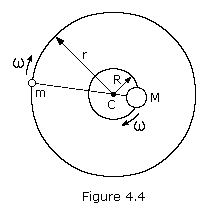 Let's examine the case of two bodies of masses M and m moving in circular orbits under the influence of each other's gravitational attraction. The center of mass of this system of two bodies lies along the line joining them at a point C such that mr = MR. The large body of mass M moves in an orbit of constant radius R and the small body of mass m in an orbit of constant radius r, both having the same angular velocity
Let's examine the case of two bodies of masses M and m moving in circular orbits under the influence of each other's gravitational attraction. The center of mass of this system of two bodies lies along the line joining them at a point C such that mr = MR. The large body of mass M moves in an orbit of constant radius R and the small body of mass m in an orbit of constant radius r, both having the same angular velocity ![]() . For this to happen, the gravitational force acting on each body must provide the necessary centripetal acceleration. Since these gravitational forces are a simple action-reaction pair, the centripetal forces must be equal but opposite in direction. That is, m
. For this to happen, the gravitational force acting on each body must provide the necessary centripetal acceleration. Since these gravitational forces are a simple action-reaction pair, the centripetal forces must be equal but opposite in direction. That is, m![]() 2r must equal M
2r must equal M![]() 2R. The specific requirement, then, is that the gravitational force acting on either body must equal the centripetal force needed to keep it moving in its circular orbit, that is
2R. The specific requirement, then, is that the gravitational force acting on either body must equal the centripetal force needed to keep it moving in its circular orbit, that is
![]()
If one body has a much greater mass than the other, as is the case of the sun and a planet or the Earth and a satellite, its distance from the center of mass is much smaller than that of the other body. If we assume that m is negligible compared to M, then R is negligible compared to r. Thus, equation (4.7) then becomes
![]()
If we express the angular velocity in terms of the period of revolution, ![]() = 2
= 2![]() /P, we obtain
/P, we obtain

where P is the period of revolution. This is a basic equation of planetary and satellite motion. It also holds for elliptical orbits if we define r to be the semi-major axis (a) of the orbit.
A significant consequence of this equation is that it predicts Kepler's third law of planetary motion, that is P2~r3.
| In celestial mechanics where we are dealing with planetary or stellar sized bodies, it is often the case that the mass of the secondary body is significant in relation to the mass of the primary, as with the Moon and Earth. In this case the size of the secondary cannot be ignored. The distance R is no longer negligible compared to r and, therefore, must be carried through the derivation. Equation (4.9) becomes
More commonly the equation is written in the equivalent form
where a is the semi-major axis. The semi-major axis used in astronomy is always the primary-to-secondary distance, or the geocentric semi-major axis. For example, the Moon's mean geocentric distance from Earth (a) is 384,403 kilometers. On the other hand, the Moon's distance from the barycenter (r) is 379,732 km, with Earth's counter-orbit (R) taking up the difference of 4,671 km. |
Kepler's second law of planetary motion must, of course, hold true for circular orbits. In such orbits both ![]() and r are constant so that equal areas are swept out in equal times by the line joining a planet and the sun. For elliptical orbits, however, both
and r are constant so that equal areas are swept out in equal times by the line joining a planet and the sun. For elliptical orbits, however, both ![]() and r will vary with time. Let's now consider this case.
and r will vary with time. Let's now consider this case.
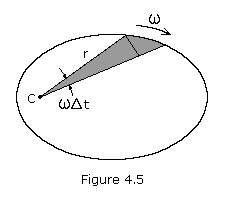 Figure 4.5 shows a particle revolving around C along some arbitrary path. The area swept out by the radius vector in a short time interval
Figure 4.5 shows a particle revolving around C along some arbitrary path. The area swept out by the radius vector in a short time interval ![]() t is shown shaded. This area, neglecting the small triangular region at the end, is one-half the base times the height or approximately r(r
t is shown shaded. This area, neglecting the small triangular region at the end, is one-half the base times the height or approximately r(r![]()
![]() t)/2. This expression becomes more exact as
t)/2. This expression becomes more exact as ![]() t approaches zero, i.e. the small triangle goes to zero more rapidly than the large one. The rate at which area is being swept out instantaneously is therefore
t approaches zero, i.e. the small triangle goes to zero more rapidly than the large one. The rate at which area is being swept out instantaneously is therefore
![]()
For any given body moving under the influence of a central force, the value ![]() r2 is constant.
r2 is constant.
Let's now consider two points P1 and P2 in an orbit with radii r1 and r2, and velocities v1 and v2. Since the velocity is always tangent to the path, it can be seen that if ![]() is the angle between r and v, then
is the angle between r and v, then
![]()
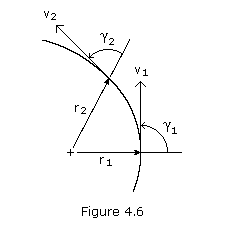
where vsin![]() is the transverse component of v. Multiplying through by r, we have
is the transverse component of v. Multiplying through by r, we have
![]()
or, for two points P1 and P2 on the orbital path
![]()
Note that at periapsis and apoapsis, ![]() = 90 degrees. Thus, letting P1 and P2 be these two points we get
= 90 degrees. Thus, letting P1 and P2 be these two points we get
![]()
Let's now look at the energy of the above particle at points P1 and P2. Conservation of energy states that the sum of the kinetic energy and the potential energy of a particle remains constant. The kinetic energy T of a particle is given by mv2/2 while the potential energy of gravity V is calculated by the equation -GMm/r. Applying conservation of energy we have
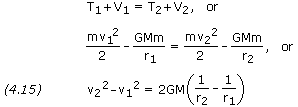
From equations (4.14) and (4.15) we obtain

Rearranging terms we get
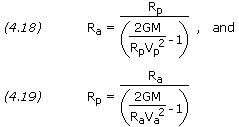
The eccentricity e of an orbit is given by
![]()
If the semi-major axis a and the eccentricity e of an orbit are known, then the periapsis and apoapsis distances can be calculated by

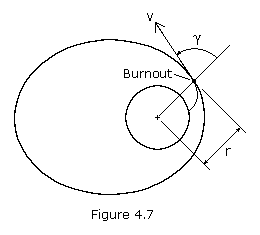 The launch of a satellite or space vehicle consists of a period of powered flight during which the vehicle is lifted above the Earth's atmosphere and accelerated to orbital velocity by a rocket, or launch vehicle. Powered flight concludes at burnout of the rocket's last stage at which time the vehicle begins its free flight. During free flight the space vehicle is assumed to be subjected only to the gravitational pull of the Earth. If the vehicle moves far from the Earth, its trajectory may be affected by the gravitational influence of the sun, moon, or another planet.
The launch of a satellite or space vehicle consists of a period of powered flight during which the vehicle is lifted above the Earth's atmosphere and accelerated to orbital velocity by a rocket, or launch vehicle. Powered flight concludes at burnout of the rocket's last stage at which time the vehicle begins its free flight. During free flight the space vehicle is assumed to be subjected only to the gravitational pull of the Earth. If the vehicle moves far from the Earth, its trajectory may be affected by the gravitational influence of the sun, moon, or another planet.
A space vehicle's orbit may be determined from the position and the velocity of the vehicle at the beginning of its free flight. A vehicle's position and velocity can be described by the variables r, v, and ![]() , where r is the vehicle's distance from the center of the Earth, v is its velocity, and
, where r is the vehicle's distance from the center of the Earth, v is its velocity, and ![]() is the angle between the position and the velocity vectors, called the zenith angle (see Figure 4.7). If we let r1, v1, and
is the angle between the position and the velocity vectors, called the zenith angle (see Figure 4.7). If we let r1, v1, and ![]() 1 be the initial (launch) values of r, v, and
1 be the initial (launch) values of r, v, and ![]() , then we may consider these as given quantities. If we let point P2 represent the perigee, then equation (4.13) becomes
, then we may consider these as given quantities. If we let point P2 represent the perigee, then equation (4.13) becomes
![]()
Substituting equation (4.23) into (4.15), we can obtain an equation for the perigee radius Rp.
![]()
Multiplying through by -Rp2/(r12v12) and rearranging, we get

Note that this is a simple quadratic equation in the ratio (Rp/r1) and that 2GM /(r1 × v12) is a nondimensional parameter of the orbit.
Solving for (Rp/r1) gives
![]()
Like any quadratic, the above equation yields two answers. The smaller of the two answers corresponds to Rp, the periapsis radius. The other root corresponds to the apoapsis radius, Ra.
Please note that in practice spacecraft launches are usually terminated at either perigee or apogee, i.e. ![]() = 90. This condition results in the minimum use of propellant.
= 90. This condition results in the minimum use of propellant.
Equation (4.26) gives the values of Rp and Ra from which the eccentricity of the orbit can be calculated, however, it may be simpler to calculate the eccentricity e directly from the equation
![]()
To pin down a satellite's orbit in space, we need to know the angle ![]() , the true anomaly, from the periapsis point to the launch point. This angle is given by
, the true anomaly, from the periapsis point to the launch point. This angle is given by

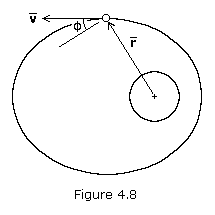 In most calculations, the complement of the zenith angle is used, denoted by
In most calculations, the complement of the zenith angle is used, denoted by ![]() . This angle is called the flight-path angle, and is positive when the velocity vector is directed away from the primary as shown in Figure 4.8. When flight-path angle is used, equations (4.26) through (4.28) are rewritten as follows:
. This angle is called the flight-path angle, and is positive when the velocity vector is directed away from the primary as shown in Figure 4.8. When flight-path angle is used, equations (4.26) through (4.28) are rewritten as follows:
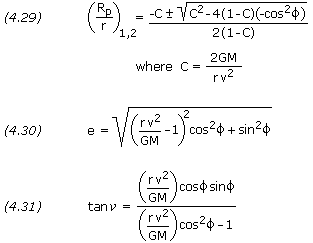
The semi-major axis is, of course, equal to (Rp+Ra)/2, though it may be easier to calculate it directly as follows:

If e is solved for directly using equation (4.27) or (4.30), and a is solved for using equation (4.32), Rp and Ra can be solved for simply using equations (4.21) and (4.22).
Orbit Tilt, Rotation and Orientation
Above we determined the size and shape of the orbit, but to determine the orientation of the orbit in space, we must know the latitude and longitude and the heading of the space vehicle at burnout.
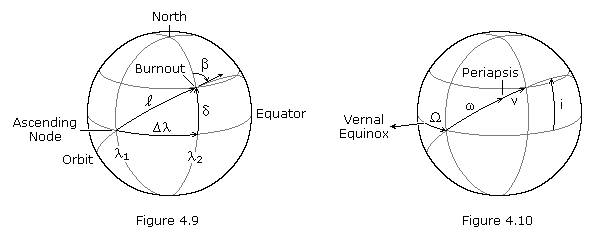
Figure 4.9 above illustrates the location of a space vehicle at engine burnout, or orbit insertion. ![]() is the azimuth heading measured in degrees clockwise from north,
is the azimuth heading measured in degrees clockwise from north, ![]() is the geocentric latitude (or declination) of the burnout point,
is the geocentric latitude (or declination) of the burnout point, ![]()
![]() is the angular distance between the ascending node and the burnout point measured in the equatorial plane, and
is the angular distance between the ascending node and the burnout point measured in the equatorial plane, and ![]() is the angular distance between the ascending node and the burnout point measured in the orbital plane.
is the angular distance between the ascending node and the burnout point measured in the orbital plane. ![]() 1 and
1 and ![]() 2 are the geographical longitudes of the ascending node and the burnout point at the instant of engine burnout. Figure 4.10 pictures the orbital elements, where i is the inclination,
2 are the geographical longitudes of the ascending node and the burnout point at the instant of engine burnout. Figure 4.10 pictures the orbital elements, where i is the inclination, ![]() is the longitude at the ascending node,
is the longitude at the ascending node, ![]() is the argument of periapsis, and
is the argument of periapsis, and ![]() is the true anomaly.
is the true anomaly.
If ![]() ,
, ![]() , and
, and ![]() 2 are given, the other values can be calculated from the following relationships:
2 are given, the other values can be calculated from the following relationships:
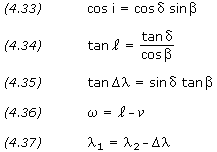
In equation (4.36), the value of ![]() is found using equation (4.28) or (4.31). If
is found using equation (4.28) or (4.31). If ![]() is positive, periapsis is west of the burnout point (as shown in Figure 4.10); if
is positive, periapsis is west of the burnout point (as shown in Figure 4.10); if ![]() is negative, periapsis is east of the burnout point.
is negative, periapsis is east of the burnout point.
The longitude of the ascending node, ![]() , is measured in celestial longitude, while
, is measured in celestial longitude, while ![]() 1 is geographical longitude. The celestial longitude of the ascending node is equal to the local apparent sidereal time, in degrees, at longitude
1 is geographical longitude. The celestial longitude of the ascending node is equal to the local apparent sidereal time, in degrees, at longitude ![]() 1 at the time of engine burnout. Sidereal time is defined as the hour angle of the vernal equinox at a specific locality and time; it has the same value as the right ascension of any celestial body that is crossing the local meridian at that same instant. At the moment when the vernal equinox crosses the local meridian, the local apparent sidereal time is 00:00. See this sidereal time calculator.
1 at the time of engine burnout. Sidereal time is defined as the hour angle of the vernal equinox at a specific locality and time; it has the same value as the right ascension of any celestial body that is crossing the local meridian at that same instant. At the moment when the vernal equinox crosses the local meridian, the local apparent sidereal time is 00:00. See this sidereal time calculator.
|
Geodetic Latitude, Geocentric Latitude, and Declination
R is the magnitude of the reference ellipsoid's geocentric radius vector to the point of interest on its surface, r is the magnitude of the geocentric radius vector to the celestial object of interest, and the altitude h is the perpendicular distance from the reference ellipsoid to the celestial object of interest. The value of R at the equator is a, and the value of R at the poles is b. The ellipsoid's flattening, f, is the ratio of the equatorial-polar length difference to the equatorial length. For Earth, a equals 6,378,137 meters, b equals 6,356,752 meters, and f equals 1/298.257. When solving problems in orbital mechanics, the measurements of greatest usefulness are the magnitude of the radius vector, r, and declination, The relationship between geodetic and geocentric latitude is,
The radius of the reference ellipsoid is given by,
The length r can be solved from h, or h from r, using one of the following,
And declination is calculated using,
For spacecraft in low earth orbit, the difference between It is important to note that the value of h is not always measured as described and illustrated above. In some applications it is customary to express h as the perpendicular distance from a reference sphere, rather than the reference ellipsoid. In this case, R is considered constant and is often assigned the value of Earth's equatorial radius, hence h = r – a. This is the method typically used when a spacecraft's orbit is expressed in a form such as "180 km × 220 km". The example problems presented in this web site also assume this method of measurement. |
Position in an Elliptical Orbit
Johannes Kepler was able to solve the problem of relating position in an orbit to the elapsed time, t-to, or conversely, how long it takes to go from one point in an orbit to another. To solve this, Kepler introduced the quantity M, called the mean anomaly, which is the fraction of an orbit period that has elapsed since perigee. The mean anomaly equals the true anomaly for a circular orbit. By definition,
![]()
where Mo is the mean anomaly at time to and n is the mean motion, or the average angular velocity, determined from the semi-major axis of the orbit as follows:
![]()
This solution will give the average position and velocity, but satellite orbits are elliptical with a radius constantly varying in orbit. Because the satellite's velocity depends on this varying radius, it changes as well. To resolve this problem we can define an intermediate variable E, called the eccentric anomaly, for elliptical orbits, which is given by
![]()
where ![]() is the true anomaly. Mean anomaly is a function of eccentric anomaly by the formula
is the true anomaly. Mean anomaly is a function of eccentric anomaly by the formula
![]()
For small eccentricities a good approximation of true anomaly can be obtained by the following formula (the error is of the order e3):
![]()
The preceding five equations can be used to (1) find the time it takes to go from one position in an orbit to another, or (2) find the position in an orbit after a specific period of time. When solving these equations it is important to work in radians rather than degrees, where 2![]() radians equals 360 degrees.
radians equals 360 degrees.
At any time in its orbit, the magnitude of a spacecraft's position vector, i.e. its distance from the primary body, and its flight-path angle can be calculated from the following equations:

And the spacecraft's velocity is given by,
![]()
The orbital elements discussed at the beginning of this section provide an excellent reference for describing orbits, however there are other forces acting on a satellite that perturb it away from the nominal orbit. These perturbations, or variations in the orbital elements, can be classified based on how they affect the Keplerian elements. Secular variations represent a linear variation in the element, short-period variations are periodic in the element with a period less than the orbital period, and long-period variations are those with a period greater than the orbital period. Because secular variations have long-term effects on orbit prediction (the orbital elements affected continue to increase or decrease), they will be discussed here for Earth-orbiting satellites. Precise orbit determination requires that the periodic variations be included as well.
Third-Body Perturbations
The gravitational forces of the Sun and the Moon cause periodic variations in all of the orbital elements, but only the longitude of the ascending node, argument of perigee, and mean anomaly experience secular variations. These secular variations arise from a gyroscopic precession of the orbit about the ecliptic pole. The secular variation in mean anomaly is much smaller than the mean motion and has little effect on the orbit, however the secular variations in longitude of the ascending node and argument of perigee are important, especially for high-altitude orbits.
For nearly circular orbits the equations for the secular rates of change resulting from the Sun and Moon are
Longitude of the ascending node:
![]()
Argument of perigee:
![]()
where i is the orbit inclination, n is the number of orbit revolutions per day, and ![]() and
and ![]() are in degrees per day. These equations are only approximate; they neglect the variation caused by the changing orientation of the orbital plane with respect to both the Moon's orbital plane and the ecliptic plane.
are in degrees per day. These equations are only approximate; they neglect the variation caused by the changing orientation of the orbital plane with respect to both the Moon's orbital plane and the ecliptic plane.
Perturbations due to Non-spherical Earth
When developing the two-body equations of motion, we assumed the Earth was a spherically symmetrical, homogeneous mass. In fact, the Earth is neither homogeneous nor spherical. The most dominant features are a bulge at the equator, a slight pear shape, and flattening at the poles. For a potential function of the Earth, we can find a satellite's acceleration by taking the gradient of the potential function. The most widely used form of the geopotential function depends on latitude and geopotential coefficients, Jn, called the zonal coefficients.
The potential generated by the non-spherical Earth causes periodic variations in all the orbital elements. The dominant effects, however, are secular variations in longitude of the ascending node and argument of perigee because of the Earth's oblateness, represented by the J2 term in the geopotential expansion. The rates of change of ![]() and
and ![]() due to J2 are
due to J2 are

where n is the mean motion in degrees/day, J2 has the value 0.00108263, RE is the Earth's equatorial radius, a is the semi-major axis in kilometers, i is the inclination, e is the eccentricity, and ![]() and
and ![]() are in degrees/day. For satellites in GEO and below, the J2 perturbations dominate; for satellites above GEO the Sun and Moon perturbations dominate.
are in degrees/day. For satellites in GEO and below, the J2 perturbations dominate; for satellites above GEO the Sun and Moon perturbations dominate.
Molniya orbits are designed so that the perturbations in argument of perigee are zero. This conditions occurs when the term 4-5sin2i is equal to zero or, that is, when the inclination is either 63.4 or 116.6 degrees.
Perturbations from Atmospheric Drag
Drag is the resistance offered by a gas or liquid to a body moving through it. A spacecraft is subjected to drag forces when moving through a planet's atmosphere. This drag is greatest during launch and reentry, however, even a space vehicle in low Earth orbit experiences some drag as it moves through the Earth's thin upper atmosphere. In time, the action of drag on a space vehicle will cause it to spiral back into the atmosphere, eventually to disintegrate or burn up. If a space vehicle comes within 120 to 160 km of the Earth's surface, atmospheric drag will bring it down in a few days, with final disintegration occurring at an altitude of about 80 km. Above approximately 600 km, on the other hand, drag is so weak that orbits usually last more than 10 years - beyond a satellite's operational lifetime. The deterioration of a spacecraft's orbit due to drag is called decay.
The drag force FD on a body acts in the opposite direction of the velocity vector and is given by the equation
where CD is the drag coefficient, The region above 90 km is the Earth's thermosphere where the absorption of extreme ultraviolet radiation from the Sun results in a very rapid increase in temperature with altitude. At approximately 200-250 km this temperature approaches a limiting value, the average value of which ranges between about 700 and 1,400 K over a typical solar cycle. Solar activity also has a significant affect on atmospheric density, with high solar activity resulting in high density. Below about 150 km the density is not strongly affected by solar activity; however, at satellite altitudes in the range of 500 to 800 km, the density variations between solar maximum and solar minimum are approximately two orders of magnitude. The large variations imply that satellites will decay more rapidly during periods of solar maxima and much more slowly during solar minima.
For circular orbits we can approximate the changes in semi-major axis, period, and velocity per revolution using the following equations:
where a is the semi-major axis, P is the orbit period, and V, A and m are the satellite's velocity, area, and mass respectively. The term m/(CDA), called the ballistic coefficient, is given as a constant for most satellites. Drag effects are strongest for satellites with low ballistic coefficients, this is, light vehicles with large frontal areas.
A rough estimate of a satellite's lifetime, L, due to drag can be computed from
where H is the atmospheric density scale height. A substantially more accurate estimate (although still very approximate) can be obtained by integrating equation (4.53), taking into account the changes in atmospheric density with both altitude and solar activity.
Perturbations from Solar Radiation
Solar radiation pressure causes periodic variations in all of the orbital elements. The magnitude of the acceleration in m/s2 arising from solar radiation pressure is
where A is the cross-sectional area of the satellite exposed to the Sun and m is the mass of the satellite in kilograms. For satellites below 800 km altitude, acceleration from atmospheric drag is greater than that from solar radiation pressure; above 800 km, acceleration from solar radiation pressure is greater.
At some point during the lifetime of most space vehicles or satellites, we must change one or more of the orbital elements. For example, we may need to transfer from an initial parking orbit to the final mission orbit, rendezvous with or intercept another spacecraft, or correct the orbital elements to adjust for the perturbations discussed in the previous section. Most frequently, we must change the orbit altitude, plane, or both. To change the orbit of a space vehicle, we have to change its velocity vector in magnitude or direction. Most propulsion systems operate for only a short time compared to the orbital period, thus we can treat the maneuver as an impulsive change in velocity while the position remains fixed. For this reason, any maneuver changing the orbit of a space vehicle must occur at a point where the old orbit intersects the new orbit. If the orbits do not intersect, we must use an intermediate orbit that intersects both. In this case, the total maneuver will require at least two propulsive burns.
Orbit Altitude Changes
The total change in velocity required for the orbit transfer is the sum of the velocity changes at perigee and apogee of the transfer ellipse. Since the velocity vectors are collinear, the velocity changes are just the differences in magnitudes of the velocities in each orbit. If we know the initial and final orbits, rA and rB, we can calculate the total velocity change using the following equations:
Note that equations (4.59) and (4.60) are the same as equation (4.6), and equations (4.61) and (4.62) are the same as equation (4.45).
For example, we may specify the size of the transfer orbit, choosing any semi-major axis that is greater than the semi-major axis of the Hohmann transfer ellipse. Once we know the semi-major axis of the ellipse, atx, we can calculate the eccentricity, angular distance traveled in the transfer, the velocity change required for the transfer, and the time required to complete the transfer. We do this using equations (4.59) through (4.63) and (4.65) above, and the following equations:
Another option for changing the size of an orbit is to use electric propulsion to produce a constant low-thrust burn, which results in a spiral transfer. We can approximate the velocity change for this type of orbit transfer by
where the velocities are the circular velocities of the two orbits.
Orbit Plane Changes
where Vi is the velocity before and after the burn, and From equation (4.73) we see that if the angular change is equal to 60 degrees, the required change in velocity is equal to the current velocity. Plane changes are very expensive in terms of the required change in velocity and resulting propellant consumption. To minimize this, we should change the plane at a point where the velocity of the satellite is a minimum: at apogee for an elliptical orbit. In some cases, it may even be cheaper to boost the satellite into a higher orbit, change the orbit plane at apogee, and return the satellite to its original orbit.
Typically, orbital transfers require changes in both the size and the plane of the orbit, such as transferring from an inclined parking orbit at low altitude to a zero-inclination orbit at geosynchronous altitude. We can do this transfer in two steps: a Hohmann transfer to change the size of the orbit and a simple plane change to make the orbit equatorial. A more efficient method (less total change in velocity) would be to combine the plane change with the tangential burn at apogee of the transfer orbit. As we must change both the magnitude and direction of the velocity vector, we can find the required change in velocity using the law of cosines,
where Vi is the initial velocity, Vf is the final velocity, and As can be seen from equation (4.74), a small plane change can be combined with an altitude change for almost no cost in Another option is to complete the maneuver using three burns. The first burn is a coplanar maneuver placing the satellite into a transfer orbit with an apogee much higher than the final orbit. When the satellite reaches apogee of the transfer orbit, a combined plane change maneuver is done. This places the satellite in a second transfer orbit that is coplanar with the final orbit and has a perigee altitude equal to the altitude of the final orbit. Finally, when the satellite reaches perigee of the second transfer orbit, another coplanar maneuver places the satellite into the final orbit. This three-burn maneuver may save propellant, but the propellant savings comes at the expense of the total time required to complete the maneuver.
When a plane change is used to modify inclination only, the magnitude of the angle change is simply the difference between the initial and final inclinations. In this case, the initial and final orbits share the same ascending and descending nodes. The plane change maneuver takes places when the space vehicle passes through one of these two nodes.
In some instances, however, a plane change is used to alter an orbit's longitude of ascending node in addition to the inclination. An example might be a maneuver to correct out-of-plane errors to make the orbits of two space vehicles coplanar in preparation for a rendezvous. If the orbital elements of the initial and final orbits are known, the plane change angle is determined by the vector dot product. If ii and The plane change maneuver takes place at one of two nodes where the initial and final orbits intersect. The latitude and longitude of these nodes are determined by the vector cross product. The position of one of the two nodes is given by
Knowing the position of one node, the second node is simply
Orbit Rendezvous
Orbital transfer becomes more complicated when the object is to rendezvous with or intercept another object in space: both the interceptor and the target must arrive at the rendezvous point at the same time. This precision demands a phasing orbit to accomplish the maneuver. A phasing orbit is any orbit that results in the interceptor achieving the desired geometry relative to the target to initiate a Hohmann transfer. If the initial and final orbits are circular, coplanar, and of different sizes, then the phasing orbit is simply the initial interceptor orbit. The interceptor remains in the initial orbit until the relative motion between the interceptor and target results in the desired geometry. At that point, we would inject the interceptor into a Hohmann transfer orbit.
Launch Windows
Similar to the rendezvous problem is the launch-window problem, or determining the appropriate time to launch from the surface of the Earth into the desired orbital plane. Because the orbital plane is fixed in inertial space, the launch window is the time when the launch site on the surface of the Earth rotates through the orbital plane. The time of the launch depends on the launch site's latitude and longitude and the satellite orbit's inclination and longitude of ascending node.
Orbit Maintenance
Once in their mission orbits, many satellites need no additional orbit adjustment. On the other hand, mission requirements may demand that we maneuver the satellite to correct the orbital elements when perturbing forces have changed them. Two particular cases of note are satellites with repeating ground tracks and geostationary satellites.
After the mission of a satellite is complete, several options exist, depending on the orbit. We may allow low-altitude orbits to decay and reenter the atmosphere or use a velocity change to speed up the process. We may also boost satellites at all altitudes into benign orbits to reduce the probability of collision with active payloads, especially at synchronous altitudes.
To an orbit designer, a space mission is a series of different orbits. For example, a satellite might be released in a low-Earth parking orbit, transferred to some mission orbit, go through a series of resphasings or alternate mission orbits, and then move to some final orbit at the end of its useful life. Each of these orbit changes requires energy. The The discussion thus far has focused on the elliptical orbit, which will result whenever a spacecraft has insufficient velocity to escape the gravity of its primary. There is a velocity, called the escape velocity, Vesc, such that if the spacecraft is launched with an initial velocity greater than Vesc, it will travel away from the planet and never return. To achieve escape velocity we must give the spacecraft enough kinetic energy to overcome all of the negative gravitational potential energy. Thus, if m is the mass of the spacecraft, M is the mass of the planet, and r is the radial distance between the spacecraft and planet, the potential energy is -GmM /r. The kinetic energy of the spacecraft, when it is launched, is mv2/2. We thus have
which is independent of the mass of the spacecraft.
![]()
![]() is the air density, v is the body's velocity, and A is the area of the body normal to the flow. The drag coefficient is dependent on the geometric form of the body and is generally determined by experiment. Earth orbiting satellites typically have very high drag coefficients in the range of about 2 to 4. Air density is given by the appendix Atmosphere Properties.
is the air density, v is the body's velocity, and A is the area of the body normal to the flow. The drag coefficient is dependent on the geometric form of the body and is generally determined by experiment. Earth orbiting satellites typically have very high drag coefficients in the range of about 2 to 4. Air density is given by the appendix Atmosphere Properties.
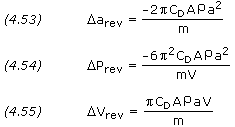
![]()
![]()
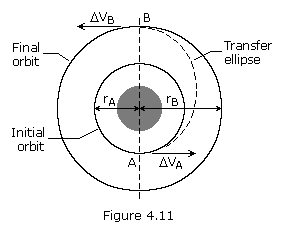 The most common type of in-plane maneuver changes the size and energy of an orbit, usually from a low-altitude parking orbit to a higher-altitude mission orbit such as a geosynchronous orbit. Because the initial and final orbits do not intersect, the maneuver requires a transfer orbit. Figure 4.11 represents a Hohmann transfer orbit. In this case, the transfer orbit's ellipse is tangent to both the initial and final orbits at the transfer orbit's perigee and apogee respectively. The orbits are tangential, so the velocity vectors are collinear, and the Hohmann transfer represents the most fuel-efficient transfer between two circular, coplanar orbits. When transferring from a smaller orbit to a larger orbit, the change in velocity is applied in the direction of motion; when transferring from a larger orbit to a smaller, the change of velocity is opposite to the direction of motion.
The most common type of in-plane maneuver changes the size and energy of an orbit, usually from a low-altitude parking orbit to a higher-altitude mission orbit such as a geosynchronous orbit. Because the initial and final orbits do not intersect, the maneuver requires a transfer orbit. Figure 4.11 represents a Hohmann transfer orbit. In this case, the transfer orbit's ellipse is tangent to both the initial and final orbits at the transfer orbit's perigee and apogee respectively. The orbits are tangential, so the velocity vectors are collinear, and the Hohmann transfer represents the most fuel-efficient transfer between two circular, coplanar orbits. When transferring from a smaller orbit to a larger orbit, the change in velocity is applied in the direction of motion; when transferring from a larger orbit to a smaller, the change of velocity is opposite to the direction of motion.
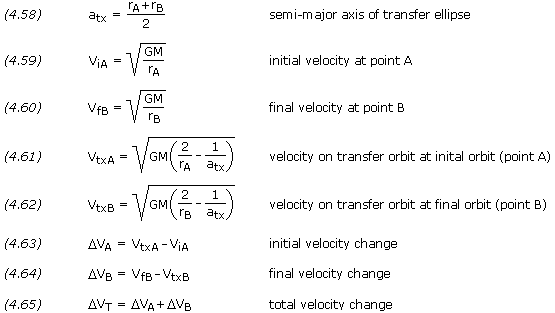
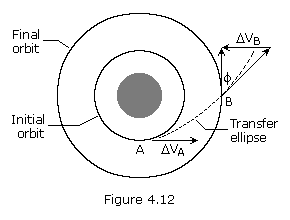 Ordinarily we want to transfer a space vehicle using the smallest amount of energy, which usually leads to using a Hohmann transfer orbit. However, sometimes we may need to transfer a satellite between orbits in less time than that required to complete the Hohmann transfer. Figure 4.12 shows a faster transfer called the One-Tangent Burn. In this instance the transfer orbit is tangential to the initial orbit. It intersects the final orbit at an angle equal to the flight path angle of the transfer orbit at the point of intersection. An infinite number of transfer orbits are tangential to the initial orbit and intersect the final orbit at some angle. Thus, we may choose the transfer orbit by specifying the size of the transfer orbit, the angular change of the transfer, or the time required to complete the transfer. We can then define the transfer orbit and calculate the required velocities.
Ordinarily we want to transfer a space vehicle using the smallest amount of energy, which usually leads to using a Hohmann transfer orbit. However, sometimes we may need to transfer a satellite between orbits in less time than that required to complete the Hohmann transfer. Figure 4.12 shows a faster transfer called the One-Tangent Burn. In this instance the transfer orbit is tangential to the initial orbit. It intersects the final orbit at an angle equal to the flight path angle of the transfer orbit at the point of intersection. An infinite number of transfer orbits are tangential to the initial orbit and intersect the final orbit at some angle. Thus, we may choose the transfer orbit by specifying the size of the transfer orbit, the angular change of the transfer, or the time required to complete the transfer. We can then define the transfer orbit and calculate the required velocities.
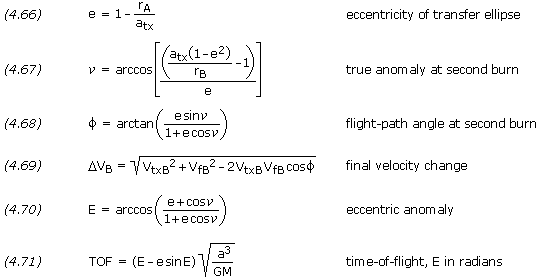
![]()
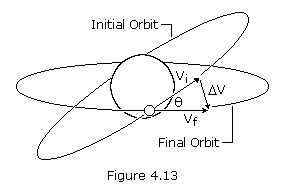 To change the orientation of a satellite's orbital plane, typically the inclination, we must change the direction of the velocity vector. This maneuver requires a component of
To change the orientation of a satellite's orbital plane, typically the inclination, we must change the direction of the velocity vector. This maneuver requires a component of ![]() V to be perpendicular to the orbital plane and, therefore, perpendicular to the initial velocity vector. If the size of the orbit remains constant, the maneuver is called a simple plane change. We can find the required change in velocity by using the law of cosines. For the case in which Vf is equal to Vi, this expression reduces to
V to be perpendicular to the orbital plane and, therefore, perpendicular to the initial velocity vector. If the size of the orbit remains constant, the maneuver is called a simple plane change. We can find the required change in velocity by using the law of cosines. For the case in which Vf is equal to Vi, this expression reduces to
![]()
![]() is the angle change required.
is the angle change required.
![]()
![]() is the angle change required. Note that equation (4.74) is in the same form as equation (4.69).
is the angle change required. Note that equation (4.74) is in the same form as equation (4.69).
![]() V or propellant. Consequently, in practice, geosynchronous transfer is done with a small plane change at perigee and most of the plane change at apogee.
V or propellant. Consequently, in practice, geosynchronous transfer is done with a small plane change at perigee and most of the plane change at apogee.
![]() i are the inclination and longitude of ascending node of the initial orbit, and if and
i are the inclination and longitude of ascending node of the initial orbit, and if and ![]() f are the inclination and longitude of ascending node of the final orbit, then the angle between the orbital planes,
f are the inclination and longitude of ascending node of the final orbit, then the angle between the orbital planes, ![]() , is given by
, is given by
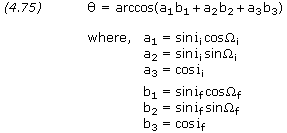
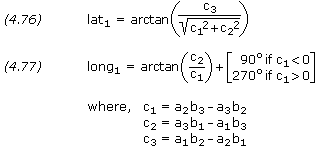
![]()
![]() V Budget
V Budget
![]() V budget is traditionally used to account for this energy. It sums all the velocity changes required throughout the space mission life. In a broad sense the
V budget is traditionally used to account for this energy. It sums all the velocity changes required throughout the space mission life. In a broad sense the ![]() V budget represents the cost for each mission orbit scenario.
V budget represents the cost for each mission orbit scenario.

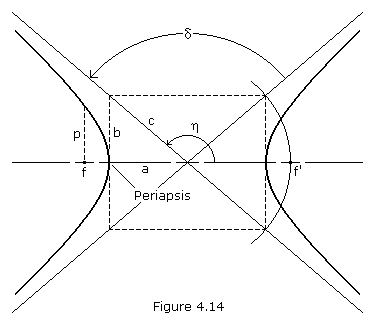 |
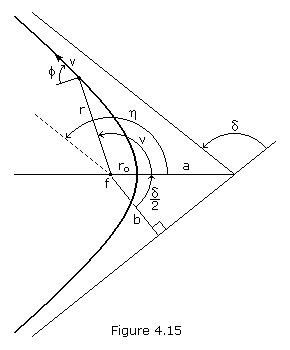 |
![]()
The angle between the asymptotes, which represents the angle through which the path of a space vehicle is turned by its encounter with a planet, is labeled If we let If we know the radius, r, velocity, v, and flight path angle, The true anomaly corresponding to known valves of r, v and Whenever The impact parameter, b, is the distance of closest approach that would result between a spacecraft and planet if the spacecraft trajectory was undeflected by gravity. The impact parameter is,
Closet approach occurs at periapsis, where the radius distance, ro, is equal to
p is a geometrical constant of the conic called the parameter or semi-latus rectum, and is equal to
At any known true anomaly, the magnitude of a spacecraft's radius vector, its flight-path angle, and its velocity can be calculated using equations (4.43), (4.44) and (4.45).
Early we introduced the variable eccentric anomaly and its use in deriving the time of flight in an elliptical orbit. In a similar manner, the analytical derivation of the hyperbolic time of flight, using the hyperbolic eccentric anomaly, F, can be derived as follows:
where,
Whenever
Hyperbolic Excess Velocity
Note that if v∞ = 0 (as it is on a parabolic trajectory), the burnout velocity, vbo, becomes simply the escape velocity.
It is, of course, absurd to talk about a space vehicle "reaching infinity" and in this sense it is meaningless to talk about escaping a gravitational field completely. It is a fact, however, that once a space vehicle is a great distance from Earth, for all practical purposes it has escaped. In other words, it has already slowed down to very nearly its hyperbolic excess velocity. It is convenient to define a sphere around every gravitational body and say that when a probe crosses the edge of this sphere of influence it has escaped. Although it is difficult to get agreement on exactly where the sphere of influence should be drawn, the concept is convenient and is widely used, especially in lunar and interplanetary trajectories. For most purposes, the radius of the sphere of influence for a planet can be calculated as follows:
where Dsp is the distance between the Sun and the planet, Mp is the mass of the planet, and Ms is the mass of the Sun. Equation (4.89) is also valid for calculating a moon's sphere of influence, where the moon is substituted for the planet and the planet for the Sun.
Compiled, edited and written in part by Robert A. Braeunig, 1997, 2005, 2007, 2008, 2011, 2012, 2013.
![]() . This turning angle is related to the geometry of the hyperbola as follows:
. This turning angle is related to the geometry of the hyperbola as follows:
![]()
![]() equal the angle between the periapsis vector and the departure asymptote, i.e. the true anomaly at infinity, we have
equal the angle between the periapsis vector and the departure asymptote, i.e. the true anomaly at infinity, we have
![]()
![]() , of a point on the orbit (see Figure 4.15), we can calculate the eccentricity and semi-major axis using equations (4.30) and (4.32) as previously presented. Note that the semi-major axis of a hyperbola is negative.
, of a point on the orbit (see Figure 4.15), we can calculate the eccentricity and semi-major axis using equations (4.30) and (4.32) as previously presented. Note that the semi-major axis of a hyperbola is negative.
![]() can be calculated using equation (4.31), however special care must be taken to assure the angle is placed in the correct quadrant. It may be easier to first calculate e and a, and then calculate true anomaly using equation (4.43), rearranged as follows:
can be calculated using equation (4.31), however special care must be taken to assure the angle is placed in the correct quadrant. It may be easier to first calculate e and a, and then calculate true anomaly using equation (4.43), rearranged as follows:
![]()
![]() is positive,
is positive, ![]() should be taken as positive; whenever
should be taken as positive; whenever ![]() is negative,
is negative, ![]() should be taken as negative.
should be taken as negative.
![]()
![]()
![]()
![]()
![]()
![]() is positive, F should be taken as positive; whenever
is positive, F should be taken as positive; whenever ![]() is negative, F should be taken as negative.
is negative, F should be taken as negative.
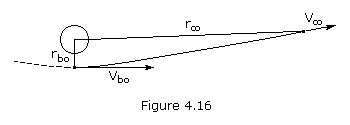 If you give a space vehicle exactly escape velocity, it will just barely escape the gravitational field, which means that its velocity will be approaching zero as its distance from the force center approaches infinity. If, on the other hand, we give our vehicle more than escape velocity at a point near Earth, we would expect the velocity at a great distance from Earth to be approaching some finite constant value. This residual velocity the vehicle would have left over even at infinity is called hyperbolic excess velocity. We can calculate this velocity from the energy equation written for two points on the hyperbolic escape trajectory – a point near Earth called the burnout point and a point at infinite distance from Earth where the velocity will be the hyperbolic excess velocity, v∞. Solving for v∞ we obtain
If you give a space vehicle exactly escape velocity, it will just barely escape the gravitational field, which means that its velocity will be approaching zero as its distance from the force center approaches infinity. If, on the other hand, we give our vehicle more than escape velocity at a point near Earth, we would expect the velocity at a great distance from Earth to be approaching some finite constant value. This residual velocity the vehicle would have left over even at infinity is called hyperbolic excess velocity. We can calculate this velocity from the energy equation written for two points on the hyperbolic escape trajectory – a point near Earth called the burnout point and a point at infinite distance from Earth where the velocity will be the hyperbolic excess velocity, v∞. Solving for v∞ we obtain
![]()
![]()
Bibliography